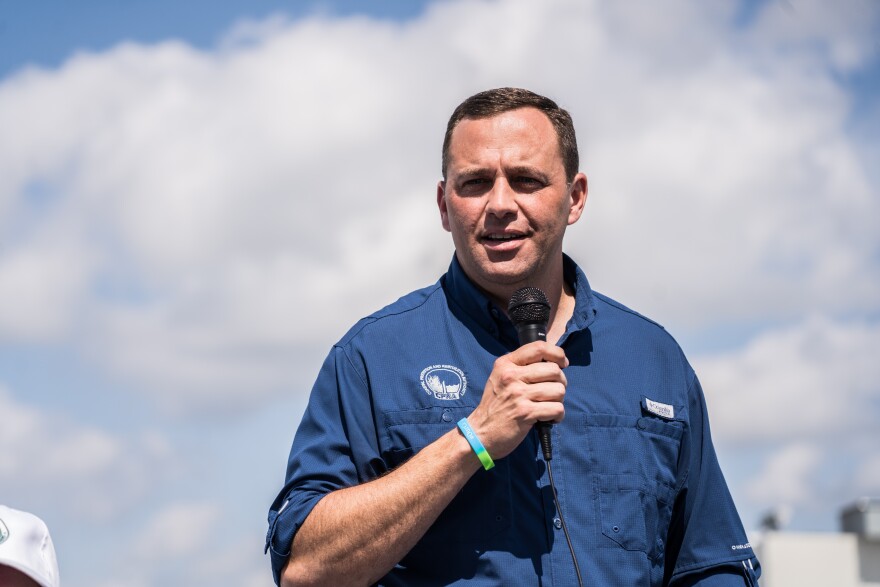In a historic decision, the U.S. Army Corps of Engineers signed off on Louisiana’s $2.2 billion plan to divert muddy Mississippi River water into Plaquemines Parish’s degraded wetlands to rebuild land on Monday.
The Mid-Barataria Sediment Diversion would be the first of its kind, attempting to mimic how the river built south Louisiana over thousands of years before humans shackled it with levees.
It’s a key piece in Louisiana’s 50-year, $50 billion plan to maintain some of the state’s lower third in the face of coastal erosion, sinking land and global sea level rise – but it’s also the most controversial.
For years, the state has faced vocal opposition from fishers and residents who work and live downstream from the diversion over fears of its impacts.
The Army Corps decision will grant Louisiana’s Coastal Protection and Restoration Authority two permits – Section 10 and Section 408 – that are critical to start construction if they accept the federal agency’s terms. If so, the state could start the five-year construction in early 2023.
CPRA Board Chairman Chip Kline said the state is still reviewing the Corps’ conditions but is "elated" at receiving authorization to proceed.
“Most importantly, this moves us toward a more resilient, more sustainable, and brighter future for communities in coastal Louisiana,” he said. “It helps restore for injuries from the Deepwater Horizon oil spill still felt in many of Louisiana’s estuaries today, and it moves us toward safeguarding this special place for future generations to enjoy.”
BP settlement dollars will pay for most of the project, should the federal and state trustees who hold the purse decide to fund the project. Their final decision is expected early next year. In past reports, the trustees have supported the project, stating the Mid-Barataria diversion is "the only way to achieve a self-sustaining marsh ecosystem in the Barataria Basin."

Maj. Gen. Diana Holland, the Corps’ Mississippi River Valley diversion’s commanding general, said all public input was taken into account when making its decision.
“The people that live and work in a project area know the area better than anyone,” Holland said Monday. “Every comment received was considered and used in reaching the final decisions.”
The decision came nearly three months after the Corps issued its final analysis weighing the environmental impacts of the two-mile-long sediment diversion in late September. In its press release, the Corps said the diversion’s current design was the least damaging of all options proposed, including taking no action at all.
During peak flood season, the diversion would send up to 75,000 cubic feet of river water into the sediment-starved marshes of Barataria Bay, cutting through Plaquemines’ west bank.
The Barataria Basin has lost more than 430 square miles of what was once almost 1,500 square miles of land since 1932. The diversion is projected to build and sustain up to 27 square miles of land by 2050, as well as maintain other state coastal restoration projects planned in the region.
The project marks the culmination of more than 40 years of advocacy and research. Rob Gorman was a founding board member of the Coalition to Restore Coastal Louisiana, one of several environmental groups dedicated to tackling the land loss crisis.
He co-authored a 1989 report titled "Coastal Louisiana: Here Today, Gone Tomorrow," which marked the end of questioning whether land loss was a problem, and instead turned the conversation toward what to do about it.
Sediment diversions were number one on their list.
“That’s the mother lode — the Mississippi River and the sediment in it,” Gorman said. “This diversion is a huge step forward. That’s the biggest tool we have in the toolbox.”

But the influx of much-needed sand and mud also means a deluge of fresh water in an area that has grown salty. The sudden change would shock species like shrimp or oysters that rely on higher salinities and make it harder for those working in the seafood industry.
Oysters, brown shrimp and largemouth bass populations are expected to shrink once the diversion starts operating before steeply dropping off in 2050. The state has allocated $305 million toward lessening the diversion’s effects, but the bulk of that money will go to coastal communities that are expected to see more flooding as a result of higher water levels.
About $54 million will go toward offsetting losses to oyster harvesters and shrimpers with initiatives like creating new public oyster grounds, improving shrimp boats for longer journeys and helping some fishers transition out of the business.
Fishers have long been the project’s most vocal opponents, and, prior to the decision, they said they’ve spent the past year and a half building their case to challenge a permit issued by the Army Corps.
On Monday, Louisiana Shrimp Association President Acy Cooper said that hasn’t changed: there will soon be lawsuits filed in court.
“We know $300 million isn’t going to be enough to take care of the industry,” he said. “ They know what’s going to happen, and for them to move forward with this is just ludicrous. It’s a damn shame.”

CPRA didn’t respond to a question about how litigation might affect the project’s timeline on Monday.
Kline said, “We look forward to finalizing the permitting process and beginning project construction as soon as possible.”
During an interview in September, CPRA Executive Director Bren Haase said he wouldn’t be surprised if the Corps encountered litigation.
“Hopefully, we have dotted our I’s, crossed our T’s, and done things the way we should have done them. And we believe we have,” Haase said.
The state has 60 days to accept or appeal the Army Corps' permit conditions.





